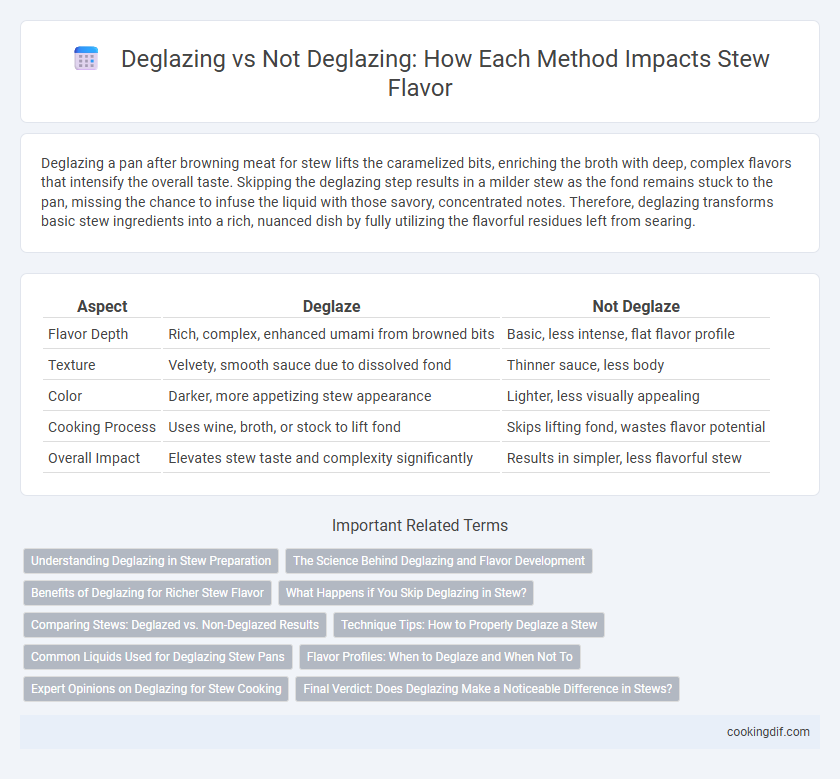Deglazing a pan after browning meat for stew lifts the caramelized bits, enriching the broth with deep, complex flavors that intensify the overall taste. Skipping the deglazing step results in a milder stew as the fond remains stuck to the pan, missing the chance to infuse the liquid with those savory, concentrated notes. Therefore, deglazing transforms basic stew ingredients into a rich, nuanced dish by fully utilizing the flavorful residues left from searing.
Table of Comparison
| Aspect | Deglaze | Not Deglaze |
|---|---|---|
| Flavor Depth | Rich, complex, enhanced umami from browned bits | Basic, less intense, flat flavor profile |
| Texture | Velvety, smooth sauce due to dissolved fond | Thinner sauce, less body |
| Color | Darker, more appetizing stew appearance | Lighter, less visually appealing |
| Cooking Process | Uses wine, broth, or stock to lift fond | Skips lifting fond, wastes flavor potential |
| Overall Impact | Elevates stew taste and complexity significantly | Results in simpler, less flavorful stew |
Understanding Deglazing in Stew Preparation
Deglazing in stew preparation involves adding liquid to the hot pan to dissolve browned food particles, enhancing the stew's depth of flavor and complexity. Skipping deglazing results in a stew with a milder taste, lacking the rich, caramelized notes that develop from the fond. Using wine, broth, or water for deglazing captures these concentrated flavors, making the final dish more savory and aromatic.
The Science Behind Deglazing and Flavor Development
Deglazing enhances stew flavor by dissolving browned caramelized bits, known as fond, which contain concentrated umami compounds and Maillard reaction products, enriching the overall taste profile. Without deglazing, these flavorful compounds remain stuck to the pan, resulting in a less complex and potentially flat stew base. The interaction of acids or alcohols used in deglazing helps extract these savory molecules, intensifying depth and promoting a richer mouthfeel.
Benefits of Deglazing for Richer Stew Flavor
Deglazing the pan after browning meat for stew releases flavorful browned bits called fond, enhancing the stew's depth and complexity. This process incorporates caramelized sugars and concentrated juices into the liquid, intensifying the savory profile. Choosing to deglaze results in a richer, more robust stew flavor compared to skipping this step.
What Happens if You Skip Deglazing in Stew?
Skipping deglazing in stew preparation results in a loss of rich, caramelized flavors from browned bits stuck to the pan, known as fond. Without deglazing, these flavorful compounds remain adhered to the cooking surface, leading to a less intense and less complex stew base. Consequently, the overall depth and savory quality of the stew's broth diminish, affecting the final taste profile significantly.
Comparing Stews: Deglazed vs. Non-Deglazed Results
Deglazing a stew pan with liquid after browning meat releases flavorful fond, intensifying the stew's depth and richness by incorporating caramelized bits into the base. Non-deglazed stews often lack this concentrated flavor, resulting in a lighter and less complex broth. Choosing to deglaze enhances savory notes and creates a more robust, satisfying flavor profile in the finished stew.
Technique Tips: How to Properly Deglaze a Stew
Properly deglazing a stew involves adding liquid--such as wine, broth, or water--to a hot pan after browning meat, scraping up the flavorful browned bits stuck to the bottom, which intensifies the stew's depth and complexity. Failing to deglaze leaves these caramelized residues unincorporated, resulting in a less robust and flatter-tasting stew. For optimal flavor, pour in the deglazing liquid while the pot is still hot and use a wooden spoon to gently loosen all the fond before adding other ingredients.
Common Liquids Used for Deglazing Stew Pans
Common liquids used for deglazing stew pans include red and white wines, which add depth and complexity to the flavor profile. Beef or chicken broth is often chosen for its rich, savory notes that enhance the stew's heartiness without overpowering other ingredients. Alternatives like apple cider vinegar or beer can introduce subtle acidity or maltiness, offering unique twists to the traditional stew base.
Flavor Profiles: When to Deglaze and When Not To
Deglazing a pan after browning meat for stew enhances flavor by lifting caramelized fond, adding depth and complexity through concentrated umami. Opt not to deglaze when aiming for a cleaner or lighter broth, as skipping this step preserves more subtle, fresh vegetable and herb notes. Understanding when to deglaze depends on the desired stew profile: rich, robust flavors benefit from deglazing, while delicate stews excel without it.
Expert Opinions on Deglazing for Stew Cooking
Experts emphasize that deglazing enhances stew flavor by dissolving browned bits, or fond, from the pan, infusing the dish with deeper, more complex savory notes. Skipping deglazing often results in a less concentrated flavor profile, as the caramelized residues remain unincorporated. Culinary authorities recommend using deglazing liquids such as wine, broth, or vinegar to extract maximum flavor and elevate the aromatic richness of the stew.
Final Verdict: Does Deglazing Make a Noticeable Difference in Stews?
Deglazing a pan after browning meat for stew intensifies the flavor by dissolving caramelized fond, enriching the broth with deep, savory notes that are otherwise absent. Stews made without deglazing may lack this concentrated umami complexity, resulting in a milder, less robust taste profile. Therefore, deglazing is a crucial step for achieving a noticeably richer and more flavorful stew.
Deglaze vs not deglaze for stew flavor Infographic

 cookingdif.com
cookingdif.com